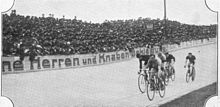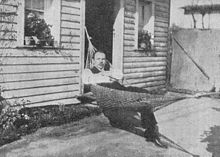Steglitz cycling track
The velodrome Steglitz was from 1905 to 1910, a sports and entertainment arena in the rural community of Steglitz in today's city of Berlin .
construction

The Steglitz cycle track was built on May 31, 1905 on the grounds of the Berliner Bau-Aktiengesellschaft on Körnerstrasse according to plans by the engineer Ebersold from Magdeburg. The client was the entrepreneur Ferdinand Knorr, whose cycling track in Friedenau had to give way in 1904 to the buildings of today's Wagner district . The area in the north of Steglitz near today 's Feuerbachstraße S-Bahn station , on which the Lothar-Bucher-Straße apartment blocks are today, is marked in a plan from 1907 as an oval as a sports field . Due to heavy rain, the opening originally planned for September 3, 1905 had to be postponed by a week to September 10. Almost 15,000 spectators saw the victory of the French world champion Gabriel Poulain in the main race over 1000 meters and that of the Berlin-based Bruno Demke in the hourly race with motorized pacemakers .
business
The 500 meter long track was twelve meters wide in the home straight and ten meters wide on the opposite side and offered seating and standing space for around 12,500 spectators. The cabs for the racing drivers were located in the brick substructure of the curves. Under the southern curve a passage led to the interior. On the side of the racetrack next to the railway stood three grandstands, in the fixed substructure of which were the apartments of the employees of the sports park as well as taprooms. On the other side, opposite the grandstands, three more bar booths and a workshop building were built on the north curve. In spring and autumn, the time when no races are held, the interior of the track was used by football clubs for their games and competitions. There were 25 tennis courts in the adjoining sports park.
The world's best riders of their time such as Thorvald Ellegaard , Louis Darragon and John Stol as well as the German cycling idol Thaddäus Robl started in Steglitz . Twice - in 1908 and 1910 - world championships were held on the cycling track, with the 1910 World Championship being an unofficial competition, the so-called "Upper World Championship". Track cycling was very popular at the beginning of the 20th century; the Berlin six-day race had existed since 1909.
By levying a pleasure tax, the cycling track represented a not inconsiderable source of income for the rural community of Steglitz. The innkeepers also benefited from the enormous number of spectators on the weekends.
"Villa Theile"
Several years before his death in 1911 - he fell fatally in a race - the Berlin racing cyclist Fritz Theile rented a shed on the grounds of the Steglitz cycling track, which he repaired himself with the help of other racing cyclists and also laid out a small garden. Theile was considered a Berlin original and was known for both its pronounced appetite and its ability to drink. The "Villa Theile" was a popular meeting place for the cycling scene at that time.
The end of the racetrack
The lease of the land company for the grounds of the sports park was no longer extended to October 1, 1910. The reason was the planned residential development on the site with the Bismarck district . However, this took almost 20 years to come and the site fell into disrepair. In 1927 the Steglitzer Anzeiger reported: “Grass and wild shrubs grow happily on the wide, still undeveloped terrain. A rural corner of the world in the middle of high residential areas. Half-hidden under tall blades of grass, the traces of the former Steglitzer Radrennbahn peep out […]. ”Shortly afterwards, large apartment blocks for the Steglitz building cooperative were built here. Today nothing in the cityscape reminds of this sports facility.
See also
Coordinates: 52 ° 27 '40.1 " N , 13 ° 19' 54.1" E
literature
- Christian Wolter : Lawn of passion. The football fields of Berlin. History and stories. Edition Else, Berlin 2011, ISBN 978-3-00-036563-8 , pp. 54-57.
References and comments
- ↑ a b On the ruins of the Steglitzer Radrennbahn ( Memento of the original from November 10, 2013 in the Internet Archive ) Info: The archive link was automatically inserted and not yet checked. Please check the original and archive link according to the instructions and then remove this notice. . In: Steglitzer Anzeiger (1927), quoted from Steglitzer Chatting Corner (around 1954)
- ↑ Plan from 1907 ( Memento of the original dated November 10, 2013 in the Internet Archive ) Info: The archive link was automatically inserted and not yet checked. Please check the original and archive link according to the instructions and then remove this notice.
- ↑ Berliner Tageblatt of September 4, 1905 and Steglitzer Anzeiger of 1927, quoted from Wolter (2011: 54).
- ↑ Landgemeinde Steglitz: First administrative report (1911) ( page no longer available , search in web archives ) Info: The link was automatically marked as defective. Please check the link according to the instructions and then remove this notice.
- ↑ At the official UCI World Championships in July, according to the Federation of German Cyclists (BDR), wrong judgments were made to the disadvantage of German racing drivers. As a result, the BDR organized its own "Upper World Championships".
- ↑ a b The Steglitzer Radrennbahn. In: Schöneberg district newspaper , May 2008
- ^ Fredy Budzinski : Fritz Theile . Biographies of famous racing cyclists 22. Berlin 1911, p. 9 f.




